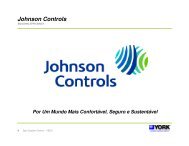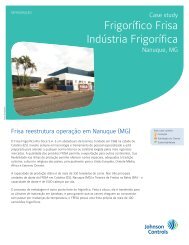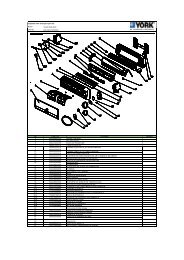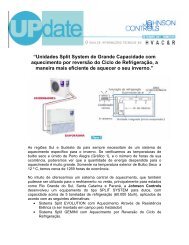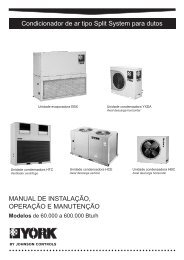Manual Técnico - Chiller YORK® Absorção YPC ... - Johnson Controls
Manual Técnico - Chiller YORK® Absorção YPC ... - Johnson Controls
Manual Técnico - Chiller YORK® Absorção YPC ... - Johnson Controls
Create successful ePaper yourself
Turn your PDF publications into a flip-book with our unique Google optimized e-Paper software.
FORM 155.17-EG4<br />
a dilution cycle that will vary in length depending on<br />
operating conditions at shutdown. Without flow, the dilution<br />
cycle will terminate early, which can lead to crystallization.<br />
Chilled water – The chilled water circuit should be designed<br />
for constant flow. A flow switch, provided standard<br />
with the unit, must be installed in the chilled water<br />
line of every unit. The switch must be located in the horizontal<br />
piping close to the unit, where the straight horizontal<br />
runs on each side of the flow switch are at least<br />
five pipe diameters in length. The switch must be electrically<br />
connected to the chilled water interlock position<br />
in the unit control center. A water strainer, of maximum<br />
1/8" mesh should be field-installed in the chilled water<br />
inlet line as close as possible to the chiller. If located<br />
close enough to the chiller, the chilled water pump may<br />
be protected by the same strainer. The flow switch and<br />
strainer assure chilled water flow during unit operation.<br />
The loss or severe reduction of water flow could seriously<br />
impair performance or even result in tube freezeup.<br />
Condenser water – Like the chilled water circuit, the<br />
tower water circuit requires a means of proving flow. The<br />
recommended method of proving flow is a tower water<br />
flow switch (not in standard supply scope, but available<br />
from YORK) installed in the tower water piping in the same<br />
manner as the chilled-water flow switch (above).<br />
The <strong>YPC</strong> <strong>Chiller</strong> is engineered for maximum efficiency<br />
at both design and part load operation by taking advantage<br />
of the colder cooling tower water temperatures<br />
which naturally occur in the winter months. In its standard<br />
configuration, <strong>YPC</strong> absorbers can tolerate entering<br />
tower water temperatures as low as 68°F (20°C).<br />
Because the unit flow rates must be maintained, the<br />
recommended method of tower water temperature control<br />
is a three-way mixing valve.<br />
At the initial startup, entering tower water temperature<br />
may be as low as 59°F (15°C), provided the water temperature<br />
rises to 68°F (20°C) within twenty minutes.<br />
On/Off Cycling<br />
Once the chiller reaches its minimum operating load, if<br />
the cooling load decreases, the leaving chilled water<br />
temperature will fall below the setpoint. When the leaving<br />
chilled water temperature falls 3°F below the setpoint,<br />
the chiller will cycle off. During a cycling shutdown, the<br />
Control Center continues to monitor the leaving chilled<br />
water temperature; when the temperature rises 1°F<br />
above the setpoint, the chiller will cycle on. The on/off<br />
cycling band used causes no noticeable effect for most<br />
cooling applications. To prevent wear damage associated<br />
with starting and stopping, it is recommended that<br />
installations be designed to prevent the two-stage absorption<br />
chiller from cycling more than twice per hour.<br />
YORK INTERNATIONAL<br />
Rupture Disk Piping<br />
All <strong>YPC</strong> <strong>Chiller</strong>s ship with a rupture disk(s) designed to<br />
fail at 12 PSIG (0.83 bar). The purpose of the rupture<br />
disk is to quickly relieve excess pressure as a precaution<br />
in the event of an emergency such as a fire. Refer<br />
to factory submittal for rupture disk size.<br />
A CPVC or fiberglass discharge pipe should run from<br />
the rupture disk to a drain. Steel rupture disk piping is<br />
not recommended unless extra care is taken to support<br />
the piping and isolate any stress from the rupture<br />
disk.The discharge piping must supported independent<br />
of the unit.<br />
Sound and Vibration Considerations<br />
Since the unit generates very little vibration, vibration<br />
eliminating mounts are not usually required. However,<br />
when the machine is installed where even mild noise is<br />
a problem, mounts or pads can be used. The use of<br />
anchoring bolts on the machine legs is not normally necessary.<br />
Thermal Insulation<br />
<strong>YPC</strong> units require thermal insulation (by others) on both<br />
hot and cold surfaces in order to achieve maximum efficiency<br />
and prevent sweating. Required insulation area<br />
is tabulated on p. 25.<br />
Simultaneous Operation<br />
<strong>YPC</strong> <strong>Chiller</strong>-Heaters equipped with an optional hotwater<br />
heat exchanger can provide both chilled water and hot<br />
water simultaneously. An understanding of the simultaneous<br />
operation feature and its limitations is required<br />
to ensure proper application. Simultaneous operation<br />
can take place only if there is a basic demand for chilled<br />
water and when an optional high temperature heater is<br />
provided. The chillers operation of the machine during<br />
simultaneous operation is initiated and controlled by the<br />
chilling load, and it is essentially the same as the normal<br />
chilling operation. The only difference is that during<br />
simultaneous operation some of the vapor generated in<br />
the first-stage generator is utilized to make hot water.<br />
To control the hot water temperature, a motorized mixing<br />
valve and two temperature controllers must be supplied<br />
and installed in the hot water circuit by the installer<br />
as shown in the sketch in Fig. 4. One controller senses<br />
the leaving hot water temperature and positions the mixing<br />
valve to maintain that temperature. The other controller<br />
acts as a limit switch and will abort simultaneous<br />
operation by placing the mixing valve in the full by-pass<br />
position and stopping the hot-water circulating pump if<br />
the leaving chilled-water temperature rises to a pre-set<br />
level (usually 50°F (10°C)), indicating that too much<br />
energy is being used to make hot water and the chiller<br />
cannot meet the chilling demand.<br />
17


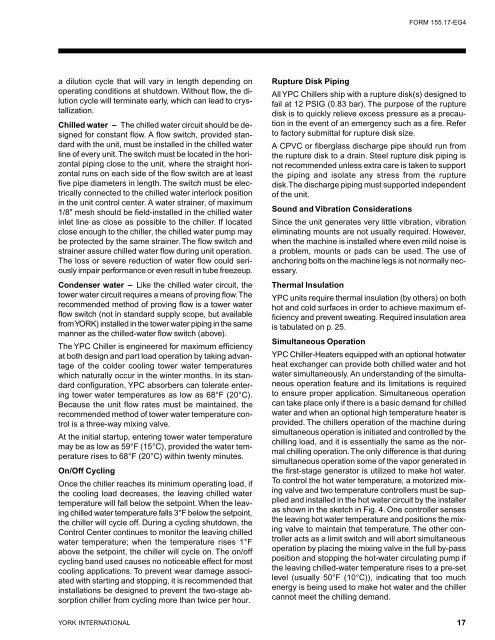
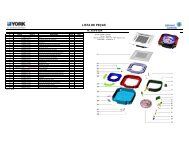

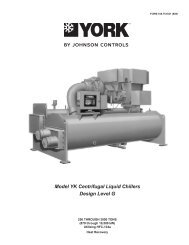
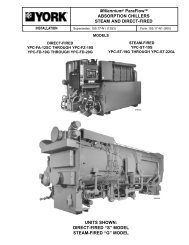
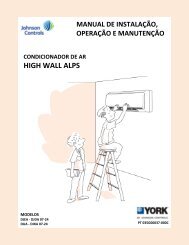
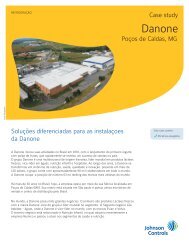
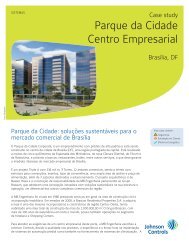

![[PDF] Catálogo Técnico YP Corrigido Corel 9 - Johnson Controls](https://img.yumpu.com/49244478/1/190x245/pdf-catalogo-taccnico-yp-corrigido-corel-9-johnson-controls.jpg?quality=85)

